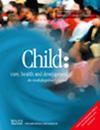Understanding the Association Between Childcare Precarity and Emotional Distress
Abstract
Background
For families with young children, securing reliable childcare may present a significant challenge. Rising costs, limited resources and the COVID-19 pandemic have heightened the precarity of childcare arrangements. Childcare precarity, defined as a state of insecure or unreliable childcare arrangements while parents work or attend school, reflects unpredictability in family life and early care and education settings and has important implications for families' economic and psychosocial well-being. This study aims at broadening the conceptualization of childcare precarity to include childcare search status and examine its association with caregiver and child emotional distress.
Methods
Participants were 3115 caregivers in the United States (88% female, 67% white) who completed the RAPID Survey between November 2022 and December 2023 and reported working or attending school. We assess whether including a childcare search status as an indicator of precarity improves the cross-sectional prediction of caregiver and child emotional distress beyond commonly used indicators (unreliability and disruptions). Using a person-centred approach, we also conduct an exploratory latent class analysis (LCA) to identify distinct experiences of childcare precarity and associated emotional distress.
Results
Childcare unreliability and disruptions were associated with caregiver distress. For children, unreliability was associated with fear/anxiety, while disruptions were associated with fussiness/defiance. Childcare search status was also linked to both caregiver and child emotional distress, improving model fit compared to baseline models. Our exploratory LCA identified a five-class solution as optimal, with emotional distress outcomes varying significantly across classes and correlating with levels of precarity.
Discussion
Our findings highlight the importance of a multidimensional approach to childcare precarity. Identifying distinct precarity profiles can inform targeted policy interventions to support diverse family needs. Future research should validate these findings and explore the broader impact of early life unpredictability.

 求助内容:
求助内容: 应助结果提醒方式:
应助结果提醒方式:


